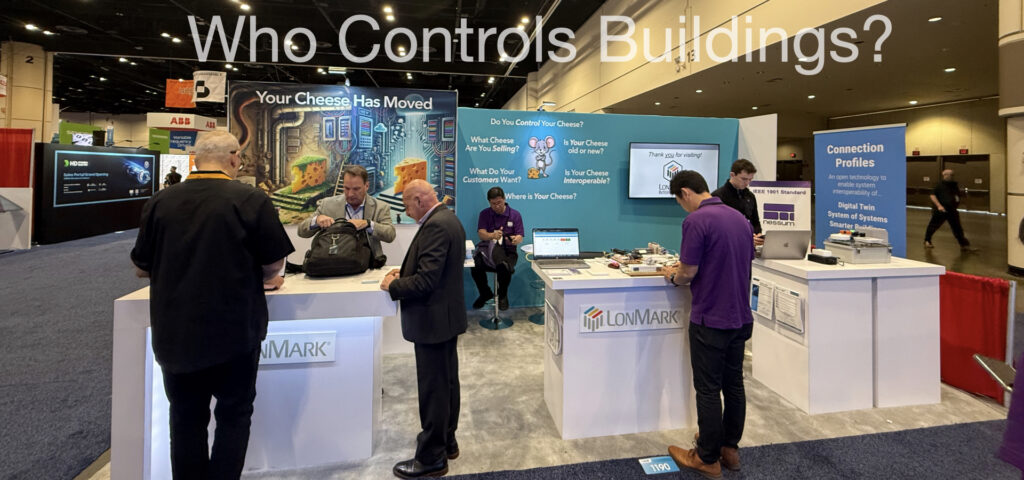Walking into AHR Expo 2025, I had one question in mind:
Who really controls our buildings?
With thousands of booths, AHR is the place to see where the industry stands on building automation, controls, and smart buildings. I wanted to know:
- Are vendors embracing open integration, or just claiming to?
- What does the Linux Foundation’s involvement mean for the future of controls?
- Who’s actually ready for change—and who’s avoiding the conversation?
After speaking with KMC Controls, 75F, and Kennady from We Write Code, it was clear:
- Some companies are fully embracing open-source and interoperability.
- Others—especially many entrenched vendors—avoided going on camera altogether.
- Manufacturers told me “it’s about time” we fix this—but saying it publicly is another story.
Then, after I posted some of these interviews to LinkedIn, a powerful comment from an owner summed up what’s happening:
“Not only do owners want choice. We are seeking out solutions to replace these old systems that are inflexible. To our current providers—look out. If your system is locked down, your days of forced monetization are coming to an end.”
— Clint Davis, Senior Civil BIM Project Manager, Denver International Airport
This is the shift happening right now. Let’s break down the interviews and why they matter.
KMC Controls: No More Lock-In—Making BACnet Work for Owners
Interview with Tim Vogel, VP of Connected Solutions of KMC Controls
KMC Controls made it clear—they want owners to have control. Their commitment to BACnet is about ensuring real interoperability, not locking people into closed ecosystems.
Key Takeaways:
- KMC plays nice with any BACnet system—even if it’s closed.
- Their cloud-based solutions allow for multi-building integration without vendor lock-in.
- They see open-source as valuable and are watching Linux Foundation’s Interoperable Building Box (IBB) closely.
- They are “Building Geniuses!”
What This Means: KMC is already leading with true openness
75F: Calling Out “Fake Open” Systems
Interview with Deepinder Singh, CEO of 75F
75F doesn’t just talk about openness—they call out the industry’s fake claims of openness.
Key Takeaways:
- Most “open” systems today are still proprietary.
- 75F follows Haystack API for true open integration beyond just BACnet and Modbus.
- Deepinder, who was part of the early Linux open-source movement
- He said: “people have kind of bastardized that term open standards and created these proprietary implementations. So, so I’m looking forward to actually the Linux Foundation coming over and helping clean stuff up”
🔹 What This Means: 75F understands that openness isn’t just about protocols—it’s about control.
Kennady from We Write Code: Why Open-Source Wins
Interview with Kennady Gales McGannon of We Write Code
Kennady, a co-founder of the Coalition for Smarter Buildings (C4SB) and a key voice in bringing building automation into the Linux Foundation, explained why open-source is critical:
Key Takeaways:
- Open-source isn’t just free—it’s more secure, scalable, and efficient.
- Connection Profiles will replace today’s fragmented, custom APIs with a standardized approach.
- The industry is at a breaking point—open-source is the only way forward.
- Kennady writes code!
What This Means: Owners finally have a chance to break free from proprietary vendors—but they need to demand it.
The Divide: Who’s Avoiding the Conversation?
While KMC, 75F, and Kennady spoke openly about the need for interoperability, many other vendors did not want to go on camera. (contact me when you are ready!)
What I Heard Off Camera:
- “It’s about time this happens.”
- “We’ve wanted open systems for years, but it’s been impossible to push through.”
- “Our company isn’t ready to talk about this yet.”
- “The cheese has moved!”
But when the camera turned on? Crickets.
The legacy control vendors who profit from lock-in didn’t want to publicly address why their systems still block interoperability.
What This Means: Owners must stop waiting for vendors to change on their own—and start demanding open systems now.
The Turning Point: Owners Are Done with Lock-In
The AHR Expo confirmed it—the industry is splitting into two groups:
- Those embracing open-source and interoperability
- Those protecting their black-box systems, hoping owners won’t notice
The problem? The owners are noticing.
Clint Davis’ LinkedIn comment makes it clear:
- Owners are actively seeking alternatives to replace outdated, closed systems.
- They are done with vendor-controlled pricing, forced upgrades, and restricted access.
Final Observations: What Happens Next?
1. Owners Must Take Control
- Vendors will keep selling proprietary black boxes as long as owners keep buying them.
- The Asset Leadership Network and other groups are pushing for governance frameworks that force open standards.
2. Open Protocols Need Real Adoption
- Interoperable Building Box (IBB) and Connection Profiles are the first real efforts to bring open-source principles to building automation.
- More vendors need to commit to these solutions, not just watch from the sidelines.
3. The Linux Foundation is a Game-Changer
- The Linux Foundation’s entry into buildings is the biggest signal yet that change is coming.
- But it won’t happen automatically—owners, developers, and innovators must demand open solutions.
AHR Expo 2025 confirmed:
If building owners and facility managers don’t demand open systems now, they will remain locked into closed, costly, and inefficient ecosystems.
- The industry wants interoperability.
- Some vendors are ready for open-source.
- But the old guard is still protecting their black boxes.
The Digital Twin vision will fail if we don’t fix interoperability first.
It’s time to act.
What do you think? Is your organization ready to break free from proprietary controls? Let’s keep the conversation going.
Coming up next are more interviews and insights from:
- Climate Control Group
- Mitsubishi Electric
- ABB
- Bubll
- Hurst Boiler
- Asset Leadership Network
Read Part II of the AHR interviews here.



